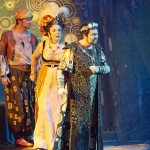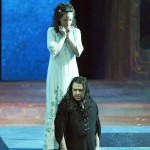
 What Richard Strauss’s Salome is about is not ‘love’ which Salome professes for Jochanaan, but desire as lust unbounded; the consequences of lust are grotesque and evil. Salome, like a child desiring what she cannot have, spitefully will have his head on a platter. And Herodes, married incestuously to Herodias, lusts after her daughter Salome. Herodes has offered- will offer- Salome ‘everything’ to see her dance: an erotic spectacle as sexual preview.
What Richard Strauss’s Salome is about is not ‘love’ which Salome professes for Jochanaan, but desire as lust unbounded; the consequences of lust are grotesque and evil. Salome, like a child desiring what she cannot have, spitefully will have his head on a platter. And Herodes, married incestuously to Herodias, lusts after her daughter Salome. Herodes has offered- will offer- Salome ‘everything’ to see her dance: an erotic spectacle as sexual preview.
The enigma of the piece is Jochanaan (John the Baptist) , the man of God who has renounced the sins of the flesh. Salome is the lascivious temptress. Woman it was who, through Eve, brought evil into the world. So he will have none of it. Yet his very stubbornness spurs her on, the spoilt Princess. Salome’s dangerous, amoral game ensnares Narraboth, Captain of the Guard, (who later commits suicide) to release Jochanaan; and this original Lolita plays a deadly poker with her step father.
Oscar Wilde, the aesthete, was inspired by paintings of the iconic Salome, the Christian biblical theme, being a tale of oriental eroticism and barbarism. But Wilde, for all his brilliant wit, was the serious moralist. Jochanaan’s faith was not to be bought, nor his integrity compromised.
Richard Strauss saw Wilde’s play (in Lachmann’s German version). Strauss’s opera was premiered in December 1905 in Dresden. Salome provided not only a showcase for Strauss’s virtuoso orchestral descriptive powers. Strauss, even in 1905, was pushing the boundaries of late Romanticism- at times prefiguring Schoenberg’s opulent early works (Pelleas und Mellisand).
The harmony of Salome employs ‘extended tonality , chromaticism, a wide range of keys, unusual modulations, tonal ambiguity and polytonality’. In the opera’s final scene -after Salome kisses the severed head- the music climaxes in a highly dissonant chord, This chord has provoked huge controversy: ‘sickening’, ‘epoch making’, ‘ecstasy falling in upon itself’. The chord jars dissonantly against Strauss’s rich orchestration; but, arguably, is crucial in Strauss’s elaborate scheme, using keys and leitmotifs to represent the opera’s characters, and their doomed fate.
And Salome’s depraved scenes and lewd sensuality shocked audiences – years ahead of Stravinsky’s Rite of Spring (1912) . Salome was initially banned in London, and in Vienna (until 1918).
Even apart from the music, the triumph of Vienna State Opera’s production (Boleslaw Barlog) is in its ‘jugendstil‘, fin-de-siecle inspired sets. Elaborately detailed, stone-effect base coverings have intricate patterns embossed in gold reminiscent of exotic and floral backgrounds to Gustav Klimt’s paintings and murals. Given the context of Wilde’s aestheticism , Strauss’s opulent orchestral scoring, Jurgen Rose’s jugendstil (art nouveau) design is especially appropriate, and enhances the opera’s mood of decadence. In addition, the gowns of Salome and Herodias, are ‘jugendstil’ -as in the premiere- with Herodias (Gwyneth Jones) wearing an outrageous multi-layered plumed hat. Salome, in the final scene, wears a long black gown with a white floral design. So that when she kneels, her patterned gown trails behind her, melting into the elaborate floral design of the set.
The highly demanding role of Salome requires ‘the volume, stamina and power of a true dramatic soprano’. Problematic is finding the ideal soprano who is also convincing as a young woman. Additionally, she needs a ballerina’s nimbleness and grace to perform the seminal ‘Dance of the Seven Veils’, Strauss’s intention-in spite of the role’s complexity -was for the singer herself to dance.
Lise Lindstrom is slim ,tall, in a long white gown, her dark brown hair in long tresses. To modulating woodwind, Lindstrom achieves very high notes effortlessly, remarking how deep the well is, how terrible to have to live there . ‘Bring the prophet out, I want to see him’ , she insists. The stage slopes like an amphitheatre , the well in the centre. A long haired figure emerges clad all in black , like a heavy metal singer. Markus Marquardt is a tremendous baritone, (his brass accompaniment interpolated by playful woodwind for Salome.)
 Lindstrom’s Salome has the lightness of a girl -playful and mischievous- unaware of the consequences of her game. ‘Who is this woman… I don’t like her eyes on me’; Jochanaan doesn’t want to know who she is, sends away the ‘daughter of Babylon’. Addressing Jochanaan, she’s in love with his Leib, his body the white of ivory, roses…His long black hair like grapes. She wants to touch it . Back! He pushes her away, Daughter of Sodom (cacophony). She desires his mouth: nothing in the world is as red, let me kiss it. Never, daughter of Babylon, is Jochanaan’s refrain, to strident orchestral intervention, very low bass, clarinets soaring.
Lindstrom’s Salome has the lightness of a girl -playful and mischievous- unaware of the consequences of her game. ‘Who is this woman… I don’t like her eyes on me’; Jochanaan doesn’t want to know who she is, sends away the ‘daughter of Babylon’. Addressing Jochanaan, she’s in love with his Leib, his body the white of ivory, roses…His long black hair like grapes. She wants to touch it . Back! He pushes her away, Daughter of Sodom (cacophony). She desires his mouth: nothing in the world is as red, let me kiss it. Never, daughter of Babylon, is Jochanaan’s refrain, to strident orchestral intervention, very low bass, clarinets soaring.
AS Herodes’ Wolfgang Schmidt’s high tenor seems rather unstable; perhaps he’s a bit mad. He senses the cold and murmuring wind as insidious omens. Herodes announces the time is nigh -( flutes shriek, clarinets comment obliquely) .’No one can tell how God works. His ways are mysterious. But the Messiah hasn’t come. Meanwhile Herodias (Gwyneth Jones) wearing that hat, waves her fan, shocked, outraged at her daughter.
The royal area is bedecked luxuriantly in exquisitely patterned cloth and spread with cushions: all very decadent. (Jochanaan, feared for his prophesies, was thrown into prison, the powerful enraged by his moral censure.) Herodes, in full oriental princely robes, will have his step-daughter dance for him . She declines, barters; will not, even for half his kingdom.
The Dance! The music of seduction is sumptuous, mysterious, with woodwind, especially flutes, evoking the exotic. How does she do? She’s tantalising , taunting, against a dialogue between strings and woodwind , peppered by percussion ,and embellished by harp. Lindstrom isn’t a professional dancer, but naturalistic, more like a drunk dare at a party.
We are all leaning -leering-over our balcony seats , for a closer look, like voyeurs. She kneels . We see her bare thighs. He’s offered emeralds, his most prized possessions, his love. She lowers her voice, still demands, (again clarinets, shrill flutes, braying horns), ‘Give me the head of Jochanaan’. Terrible bassoons, dissonant strings, a tremendous drum roll. Salome finally appears in a black dress, the head on a silver platter. She sits on the edge of the stage, kneeling in front of it.
Why doesn’t he look at me, with those closed eyes? I’m alive, you are dead; now your head belongs to me! Salome’s soliloquy is remarkable, psychologically. Jochanaan has seen his God , but not her. Had he seen her, he would have loved her. She lusts for him. Obscenely, she kisses the head. In her self-deception, it tastes like love, ‘the secret of love is greater than the secret of death.’
Herodes curses his daughter-in-law, ein Ungeheuer monster, and orders her death, sensing evil omens.
Lindstrom was impressive, but developing in the role. The cast, Schmidt, Marquardt, Jones, was distinguished. Some audience (near stage boxes) felt the leads were rather overwhelmed by the over-loud orchestra. Nevertheless Vienna State Opera Orchestra, truly marvellous, under the experienced Ulf Schirmer, affirmed that in Strauss they are unsurpassed. Salome is not a comfortable experience.
14.05.12
Photos: Lise Lindstrom (Salome); Gwyneth Jones (Herodias) and Wolfgang Schmidt (Herodius); Lise Lindstrom (Salome) and Markus Marquardt (Jochanaan)
(c) Wiener Staatsoper / Michael Poehn
viennaoperareview.com
Vienna's English opera blog

I appreciate you sharing this blog article. Much obliged.